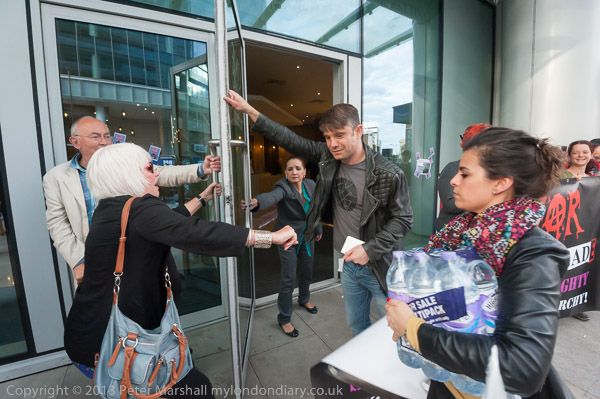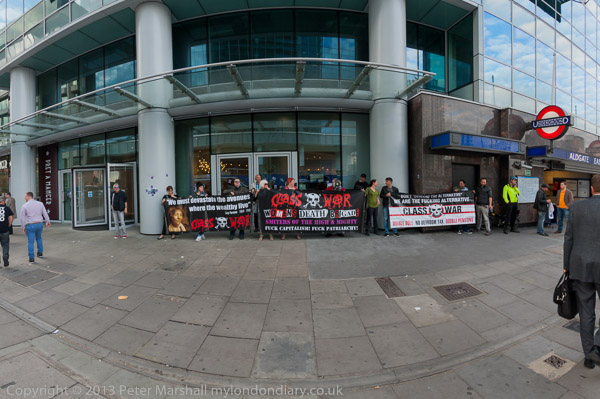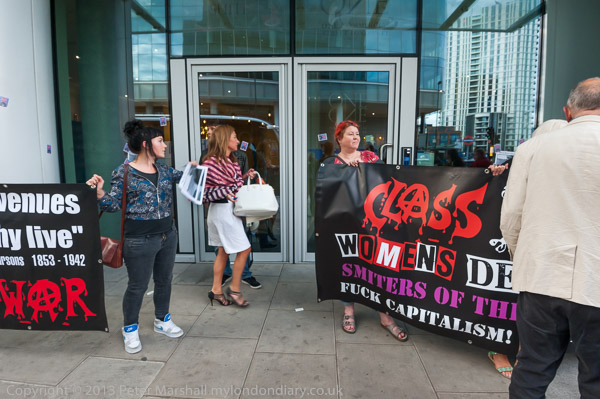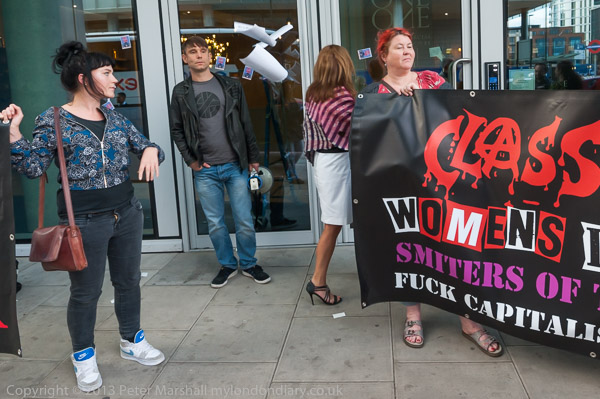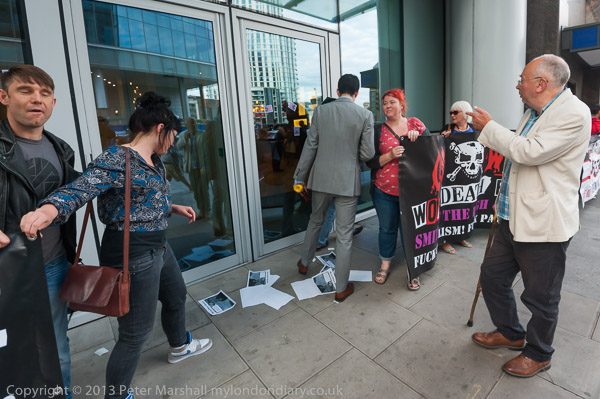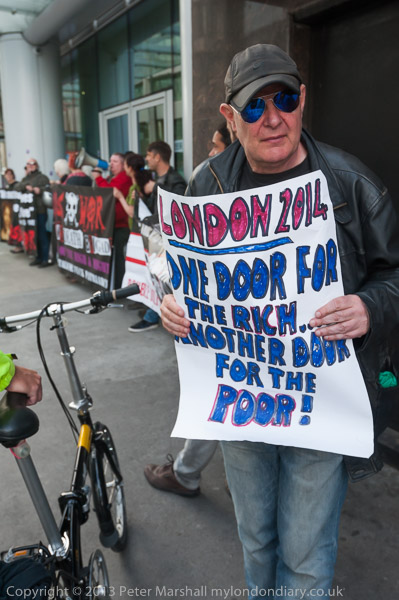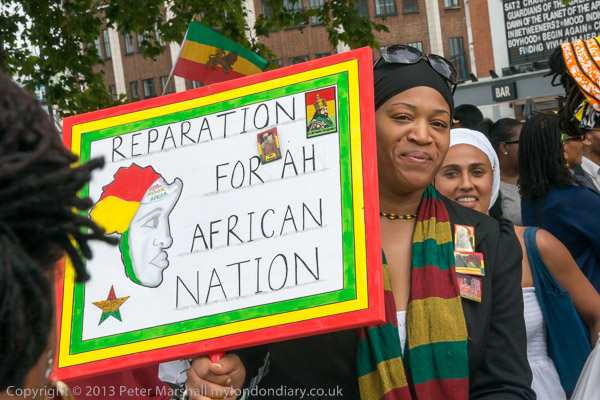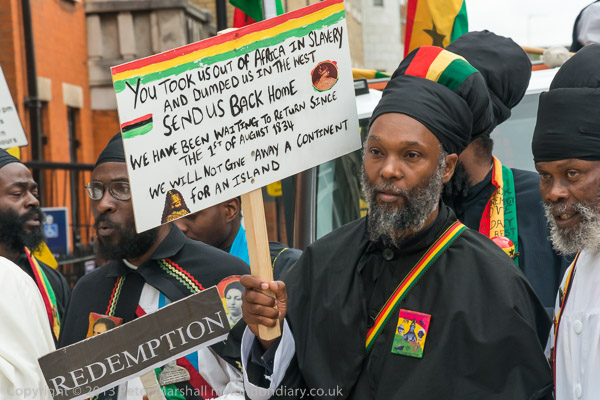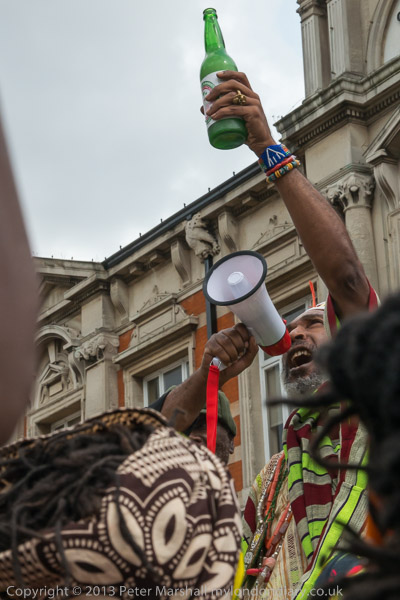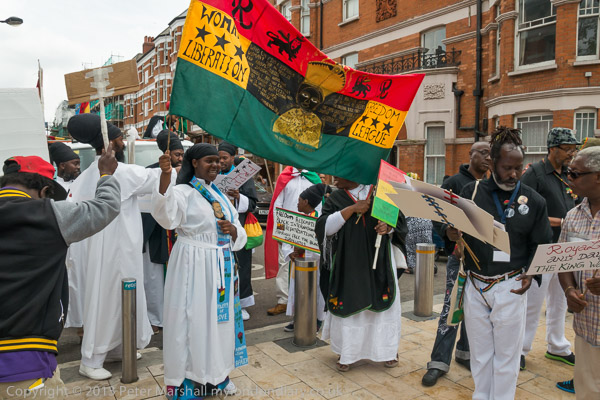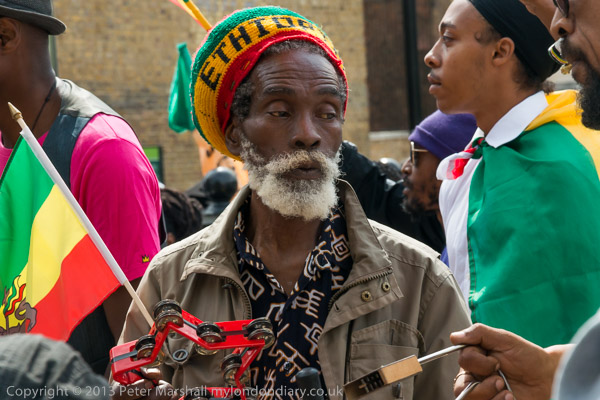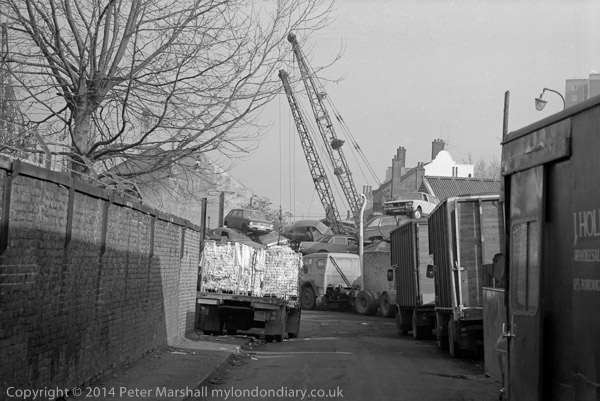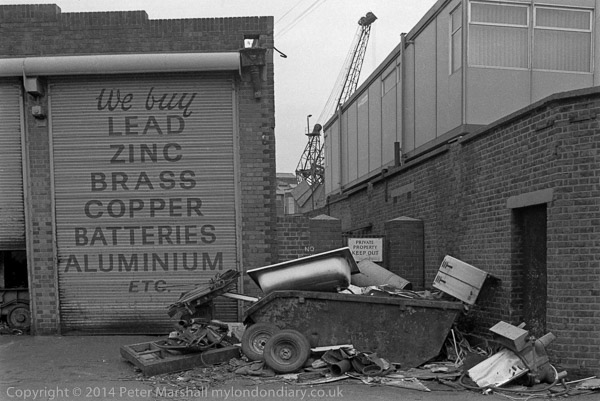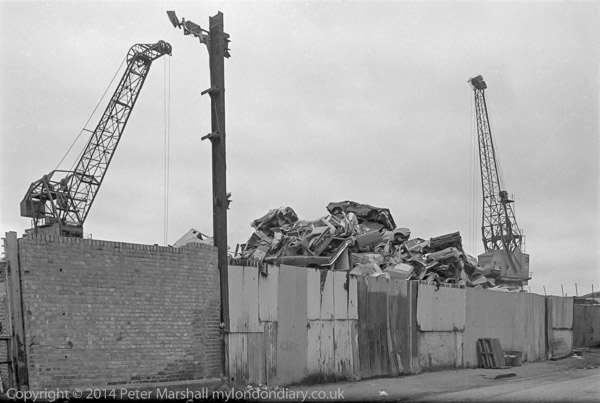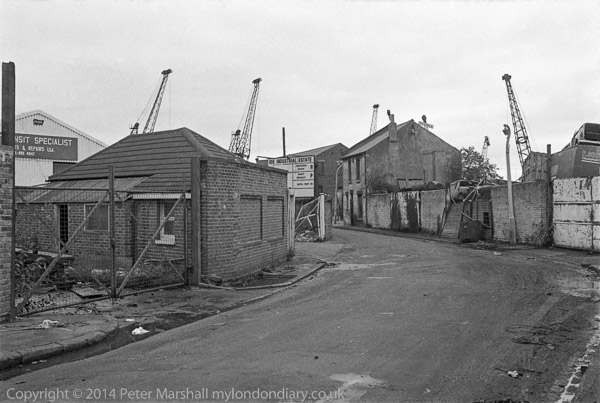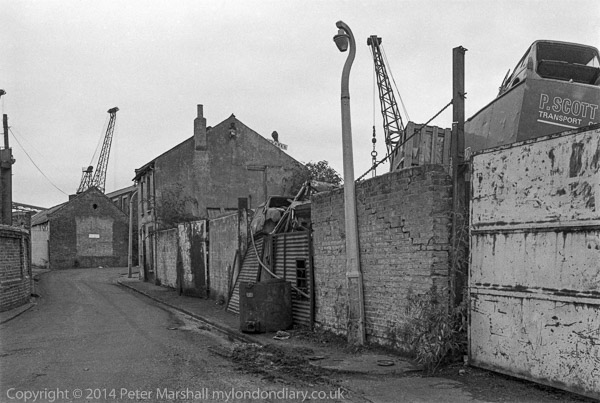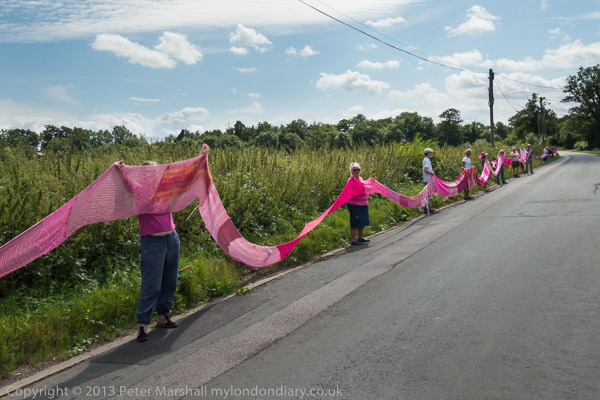
A short section of the seven mile scarf after joining
Seven miles long – and they had a bit left over. CND’s Wool Against Weapons protest on Nagasaki Day, 69 years after the second atomic bomb was dropped on Japan, stretched all the way from the atomic bomb factory in Burghfield to the better-known site at Aldermaston, both in rural Berkshire. Neither end is particularly easy to get to by public transport, though I have at various times walked most of the way from London to Aldermaston, (including the final Reading to Aldermaston section of the CND Aldermaston March in 2004) it didn’t seem sensible to try to cover a 7 mile long event entirely on foot.

Joining the lengths of scarf at the roadside
Hand-knitting or crocheting a scarf of this length and getting it into place clearly needed a great deal of planning and coordination. If people were knitting a 5 ft scarf you need a thousand of them for each mile and one of the major points about the protest was to get a great many people around the country – including many who for various reasons are unable or unwilling to get out on the streets – to participate. Groups around the country organised the knitting and brought the scarves joined together in rolls of around a hundred foot to centres along the route, from where they were stretched out and joined together. Along the route there were ‘mile posts’ with small groups coordinating the event and some serving tea and coffee and snacks, each one allocated to a different region.
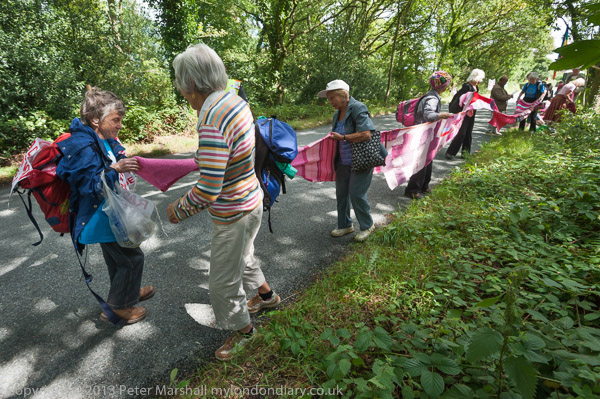
Rolling out a spool of joined scarf lengths along the route
I could have got a lift to the route from the nearest rail station – Mortimer – but decided I needed to be more mobile, and the ideal way for the kind of distance and roads involved was a bicycle. It would have been a long ride from home, but was easy to take it with me on the train to Reading, with Burghfield, where the London Region of CND was meeting a around half an hour’s ride away.
I’d planned it so I could take a relatively slow ride along the whole route, jumping off my bike wherever I saw an opportunity to take photographs, stopping at all of the mile posts to photograph what was happening there, and also between them where people were rolling out and joining up the scarf. A bike has the great advantage that you can jump off anywhere, lean the bike against a fence or a tree or on the ground and take pictures. The route was along narrow country roads – some quite busy with traffic – and with relatively few places where it would be easy to park a car, particularly as the police were intent on keep traffic moving along the road as well as avoiding the protesters becoming roadkill. It took me around 75 minutes to cover the 7 miles to the fence of the site at Aldermaston.
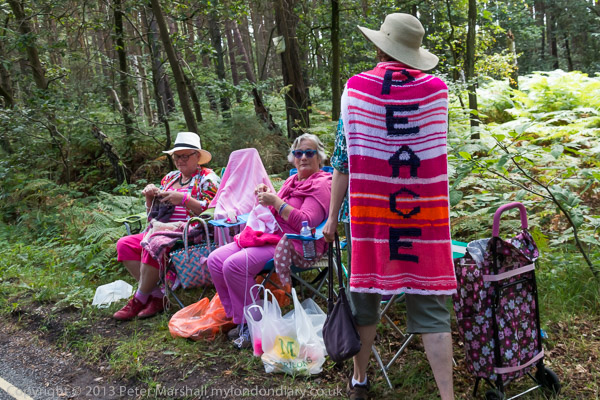
Two women were still knitting away at Aldermaston. Eventually the scarves will be turned into blankets for refugees
I’d wanted to be sure to cover as much as possible of the activities involved in the protest, and arriving at Aldermaston I was pleased to find a couple of women still knitting scarves, as well as a large display of various banners tied to the fence and to roadside trees.
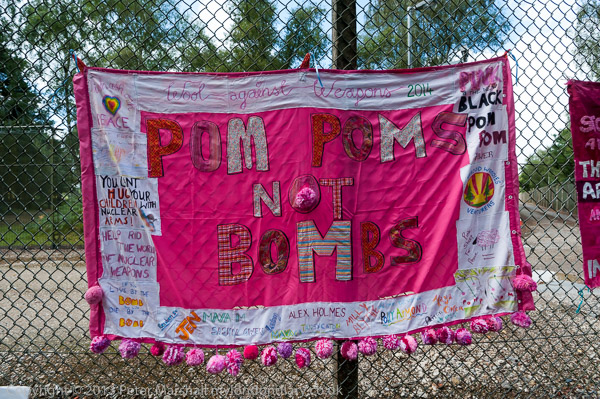
‘Pom Poms not Bombs’ on the fence at Aldermaston AWE
Going back to Burghfield was considerably faster – helped by a little wind and a longish downhill stretch, but mainly by only stopping once to take a few pictures – I made it roughly three times as fast. I even sped past the turning to Burghfield, but quickly realised my mistake as there was no roadside scarf, and had to brake and turn around.
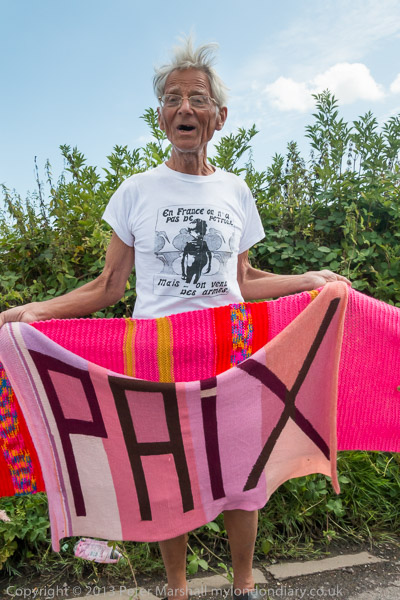
Anti-nuclear protesters from France joined in and had knitted some scarves
The event had been planned to reach its climax at 1pm exactly, and stewards were phoning anxiously to check along the route that the whole length had been joined. They got the message just in time and everyone along the route was lifting up the scarf and making a lot of noise with bells and whistles. I’d decided to run along and take pictures of as much as I could during the few minutes they would keep this up, keeping on foot as there would be people to photograph every few yards of my way, and this worked well. Stopping to take pictures meant I only covered a little over half a mile, although I got quite exhausted from running with a heavy bag between the frequent stops to take pictures.
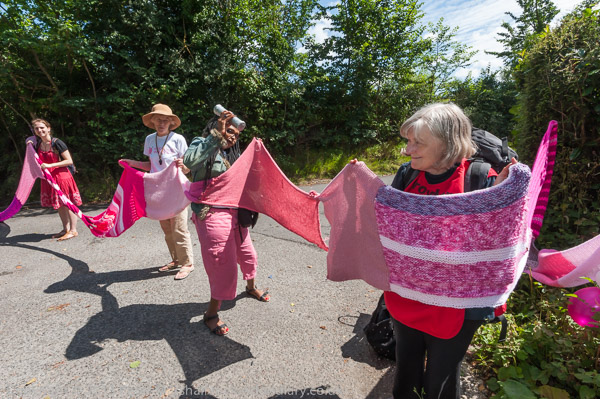
Dancing with the scarf where it crossed a minor side road on the route
I stopped and talked with one group who were holding the scarf at a minor road junction – lifting it up over a car that wanted to go down the side road, and dancing around the rest of the time. The sun was coming almost directly from behind them and their shadows were dancing with them on the road. The strong back-lighting took a little work in Lightroom to get the results that I wanted, but there was no way I could have used flash fill with a group strung out away from the camera.
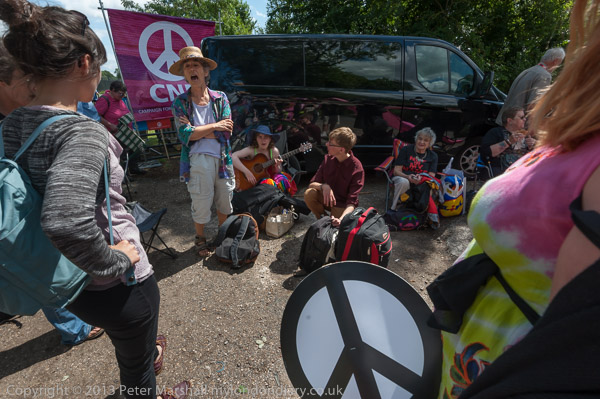
CND symbols and Pete Seeger’s ‘Where have all the flowers gone?’ took me back to the sixties
Back at the Burghfield base things were very much getting back into sixties mode – I’m sure they were singing ‘Where Have All the Flowers Gone?’ when I took the picture above and there were other songs and poetry readings, as well as some political speeches. I sat around for a while to recover from my run up the lane and back and after listening to CND General Secretary Kate Hudson decided I had the energy to cycle back to Reading for the train home and the lengthy editing of my pictures.
I was quite pleased with the set of pictures, taken with my usual Nikon D700 with 16-35mm and D800E with 18-105mm DX, though more for the overall view they gave of the event than for any individual images, though I had a nice set from my run after the joining up had been confirmed. But there were one or two places where back home looking at the pictures I could clearly see I’d missed an opportunity. The most glaring was at the Aldermaston fence, where I hadn’t recorded the longest and largest banner in a single image.
I’ve got ‘What would you spend‘ in one frame and ‘you spend £100 million on?’ in another, but really getting the whole thing together would have been rather better! If I’d taken them from the same place with the same focal length I could have joined them up, but rather better would have been to have used the 8mm fisheye to get it all in a single frame. I was just in too much of a rush, too worried about actually making it back to Burghfield, and not realising quite how much faster my return journey would be.
Wool Against Weapons.
Continue reading A long pink scarf
